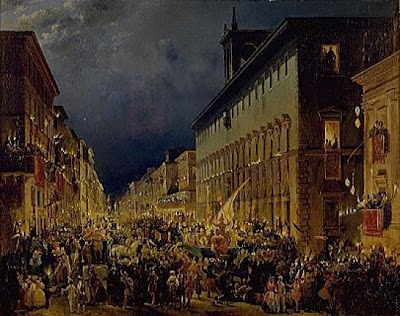Today is the first day of Carnival, and we all know the celebrations in Rome can't rival those Venice. In fact these days no one associates Carnival with Rome. But just a few hundred years ago (the blink of an eye in Rome-time), Rome was the place to be to celebrate this raucous, bacchanalian late-winter event.
Carnival is a ten day period (in the past it was much longer and sometimes began right after Christmas, on St. Stephen's day) that directly precedes Lent, the 40-day period in the Catholic liturgical calendar that in turn precedes Easter. In the Catholic religion, Lent is a period of sober reflection and abstinence from the earthly pleasures of life. Although today most Catholics try to give up one or two things they particularly enjoy (I always try to give up sugar or chocolate), traditionally it was a time of general fasting, during which alcohol, meat and rich foods were not consumed. Carnival was the last hurrah before this strict period of restraint, and in fact the name, Carnevale in Italian, derives from the phrase "farewell to meat" as this was the last chance to eat it for a while. It could also be translated as "farewell to the flesh," and in fact, part of the reason masks were worn was to facilitate marital infidelity and other no-nos.
 |
| Detail from Carnival in Rome, Johannes Lingelbach, ca 1650 |
In Rome, a city that was at times repressed due to papal influence (I say "at times" because certain popes were more lascivious than kings), Carnival was celebrated with particular exuberance. (Carnival celebrations have also been linked to pre-Christian winter festivities such as Saturnalia.) In addition to masked balls, theatrical spectacles, bull fights and general carousing, the most popular pastimes took place on Via del Corso.
 |
| Roman Carnival, Ippolito Caffi |
Previously called Via Lata, this wide straight road leading from Piazza Venezia to Piazza del Popolo has been an important thoroughfare in Rome since ancient times, connecting with Via Flaminia and continuing into northern Italy. During the Renaissance and beyond, it became the place to be seen during Carnival. Horse-drawn coaches would drive up and down the street, with people in garish costumes and elaborate masks greeting each other and often playing pranks. The wealthy citizens would rent rooms in the palaces that faced Via del Corso to watch the spectacle from above.
 |
| Carnival on the Corso, Ippolito Caffi |
More exciting still, Via del Corso was also the site of many races (in fact, the street's name was changed for this very reason, corso in Italian means race.) Most famous was the corso dei berberi, the Race of the Berbers, when riderless Berber horses would race from the top to the bottom of Via del Corso. The empty saddles of the unfortunate creatures were studded with nails to make them run faster.
 |
| The retaking of the Berbers, Achille Pinelli, 1832 |
 |
| The Candle race on Via del Corso, Ippolito Caffi, ca 1850 |
Today Roman Carnevale has become mostly a holiday for children when they dress up in costume, throw confetti and are paraded around town by their proud parents. But Rome is trying to revive the ancient traditions (without the cruel races, thankfully!) and this year a record number of events are on offer, from exhibits, to dance and music performances to balls, and most notably several equestrian shows. Events kick off tonight at the historic center of the Carnival action, Piazza del Popolo, with a performance by the orchestra of the Opera di Roma.
Visit the official site of Carnevale Romano, with a detailed list of events.
Photos 1 and 7 by Robbi Huner and Barbara Roppo, courtesy of Zétema Press Office
Other photo sources: 2, 3, 4, 5, 6
Other photo sources: 2, 3, 4, 5, 6
Liked it? Then share:



